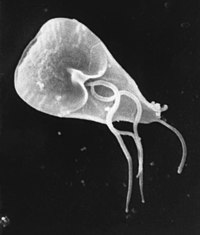Diplomonadida
Giardia lamblia is an anaerobic parasite that colonizes and reproduces in the small intestine. It causes abdominal cramps and severe diarrhea. People pick up Giardia by drinking water that is contaminated with human feces.
Parabasala
Trichomonas vaginalis inhabits a female's vagina. It has both flagella and an undulating membrane. These structures allow the protist to move within the reproductive and urinary tracts of it's host.
Euglenozoa
Kinetoplastids has a large mitochondria with an organelle called the kinetoplast. The kinetoplast holds extranuclear DNA. The kinetoplastid are symbiotic and pathogenic to their hosts.
Alveolata
Dinoflagellates are abundant in aquatic pastures of phytoplankton near the water surface. Most are unicellar, having a shape reinforced by internal plates of cellulose. When they bloom, they cause red tides in coastal waters. Toxins produced have killed fish and invertebrates, which can also be deadly to humans as well.
Apicomplexans are parasites of animals. These parasites can disseminate as tiny infectious cells called sporozoites. The sporozoites contain specialized organelles for penetrating host cells and tissues. They have a complex life cycle, usually involving two or more host cells.
Stramenopila
Diatoms have unique glasslike walls, with each wall overlapping each other. They reproduce asexually by mitotic cell divisions. Both freshwater and marine plankton are rich in diatoms. These diatoms store food reserves in the form of a glucose polymer called the laminarin.
Golden algae are biflagellated with both flagella attached near the end of the cell. They are mixotrophic and unicellular.
Rhodophyta
Red algae lack flagella and are adapted to different water depths. The red algae is the most abundant large algae in the warm coastal waters of tropical oceans. They are multicellular, and also similar to the seaweed brown algae.
Chlorophyta
Green algae are named for their chloroplasts. Their common ancestors might have chloroplasts from cyanobacteria. They are closely related to land plants. Most chlorophytes live in plankton or inhabit damp soil or snow while some live symbiotically with other eukaryotes. They also live symbiotically with lichens.
Mycetozoa
Plasmodial slime molds are brightly yellow or orange pigment. They are heterotrophic with a feeding stage called the plasmodium which contains many nuclei. The plasmodium engulfs food particles by phagocytosis.
Cellular slime mold contains cells that maintain their identity and remain separated by their membranes. They are haploid organisms which have fruiting bodies that function in asexual reproduction. They have no flagellated stage.
Source: Campbell book







No comments:
Post a Comment